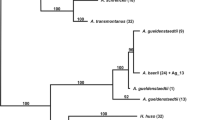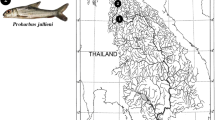Abstract
Polyploidization has played an important role in vertebrate evolution. Acipenseridae bring clear examples of polyploidy ancestry and, also, polyploidization seems to be an ongoing process in these fishes. In the present study, the genetic origin of six triploid specimens morphologically determined as Acipenser ruthenus from commercial aquaculture was analyzed using a combination of mitochondrial and nuclear markers. A further five successive statistical analyses including median joining of mitochondrial DNA control region sequences, principal coordinate analysis (PCA), factorial correspondence analysis (FCA), STRUCTURE assignation, and NewHybrids status determination for microsatellite data were applied for the clarification of the origin of one extra chromosome set added in these triploids genomes. Although interspecific hybridization had been suggested as a source of these triploids, the statistical analyses showed that the investigated triploids originate from autotriploidization rather than from interspecific hybridization. Therefore, we conclude that a combination of molecular markers with suitable statistical analyses should be used to verify the origin of unusual ploidy level. Evidently, such an approach is critically essential in aquaculture, where interspecific hybridization is very common and usually detected by changes in ploidy levels only.




Similar content being viewed by others
References
Allendorf FW, Thorgaard GH (1984) Polyploidy and the evolution of salmonid fishes. In: Ryman N, Utter F (eds) The evolutionary genetics of fishes. University of Washington Press, Seattle, pp 333–344
Anderson EC, Thompson EA (2002) A model-based method for identifying species hybrids using multilocus genetic data. Genetics 160:1217–1229
Bandelt H-J, Forster P, Röhl A (1999) Median-joining networks for inferring intraspecific phylogenies. Mol Biol Evol 16:37–48
Belkhir K, Borsa P, Chikhi L, Raufaste N, Bonhomme F (2004) GENETIX 4.05, logiciel sous Windows TM pour la génétique des populations. Laboratoire Génome, Populations, Interactions, CNRS UMR 5000, Université de Montpellier II, Montpellier, France
Bemis WE, Findeis EK, Grande L (1997) An overview of Acipenseriformes. Environ Biol Fish 48:25–71. doi:10.1023/A:1007370213924
Birstein VJ, Bemis WE, Waldman JR (1997) The threatened status of acipenseriform species: a summary. Environ Biol Fish 48:427–435. doi:10.1023/A:1007382724251
Birstein VJ, Doukakis P, DeSalle R (2000) Polyphyly of mtDNA lineages in the Russian sturgeon, Acipenser gueldenstaedtii: forensic and evolutionary implications. Conserv Genet 1:81–88
Blacklidge KH, Bidwell CA (1993) Three ploidy levels indicated by genome quantification in Acipenseriformes of North America. J Hered 84:427–430
Borin LA, Martins-Santos IC, Oliveira C (2002) A natural triploid in Trichomycterus davisi (Siluriformes, Trichomycteridae): mitotic and meiotic characterization by chromosome banding and synaptonemal complex analyses. Genetica 115:253–258
Bronzi P, Rosenthal H, Arlati G, Williot P (1999) A brief overview on the status and prospects of sturgeon farming in Western and Central Europe. J Appl Ichthyol 15:224–227. doi:10.1111/j.1439-0426.1999.tb00239.x
Centofante L, Bertollo LAC, Moreira-Filho O (2001) Comparative cytogenetics among sympatric species of Characidium (Pisces, Characiformes). Diversity analysis with the description of a ZW sex chromosome system and natural triploidy. Caryologia 54(3):253–260
De Almeida Toledo LF, Foresti F, De Toledo Filho S (1985) Spontaneous triploidy and NOR activity in Eigenmannia sp. (Pisces, Sternopygidae) from the Amazon basin. Genetica 66:85–88. doi:10.1007/BF00139713
Dettlaff TA, Ginsburg AS, Schmalhausen OI (1993) Sturgeon fishes. Developmental biology and aquaculture. Springer, Berlin
Drummond AJ, Ashton B, Buxton S, Cheung M, Cooper A, Duran C, Field M, Heled J, Kearse M, Markowitz S, Moir R, Stones-Havas S, Sturrock S, Thierer T, Wilson A (2011) Geneious v5.4. Available from: http://www.geneious.com
Dudu A, Suciu R, Paraschiv M, Georgescu SE, Costache M, Berrebi P (2011) Nuclear markers of Danube sturgeons hybridization. Int J Mol Sci 12:6796–6809. doi:10.3390/ijms12106796
Fauaz G, Vicente VE, Moreira-Filho O (1994) Natural triploidy and B chromosomes in the neotropical fish genus Astyanax (Characidae). Rev Brasil Genet 17(2):157–163
Ferris SD, Whitt GS (1980) Genetic variability in species with extensive gene duplication: the tetraploid catostomid fishes. Am Nat 115(5):650–666. doi:10.1086/283590
Flajšhans M, Vajcová V (2000) Odd ploidy levels in sturgeon suggest a backcross of interspecific hexaploid sturgeon hybrids to evolutionary tetraploid and/or octaploid parental species. Folia Zool 49:133–138
Fontana F, Congiu L, Mudrak VA, Quattro JM, Smith TIJ, Ware K, Doroshov SI (2008) Evidence of hexaploid karyotype in shortnose sturgeon. Genome 51:113–119. doi:10.1139/G07-112
Fopp-Bayat D (2007) Spontaneous gynogenesis in Siberian sturgeon Acipenser baeri Brandt. Aquac Res 38:776–779. doi:10.1111/j.1365-2109.2007.01739.x
Fopp-Bayat D, Woznicki P (2007) Spontaneous and induced gynogenesis in sterlet Acipenser ruthenus Brandt. Caryologia 60(4):315–318
Giuliano-Caetano L, Bertollo LAC (1990) Karyotypic variability in Hoplerythrinus unitaeniatus (Pisces, Characiformes, Erythrinidae). II. Occurrence of natural triploidy. Rev Brasil Genet 13(2):231–237
Gorshkova G, Gorshkov S, Gordin H, Knibb W (1996) Karyological studies in hybrids of beluga Huso huso (L.) and the Russian sturgeon Acipenser güldenstädti Brandt. Israeli J Aquacult Bamidgeh 48(1):35–39
Katoh K, Misawa K, Kuma K, Miyata T (2002) MAFFT: A novel method for rapid multiple sequence alignment based on fast Fourier transform. Nucleic Acids Res 30:3059–3066
King TL, Lubinski BA, Spidle AP (2001) Microsatellite DNA variation in Atlantic sturgeon (Acipenser oxyrinchus oxyrinchus) and cross-species amplification in the Acipenseridae. Conserv Genet 2:103–119. doi:10.1023/A:1011895429669
Linhart O, Rodina M, Flajšhans M, Mavrodiev N, Nebesarova J, Gela D, Kocour M (2006) Studies on sperm of diploid and triploid tench, Tinca tinca (L.). Aquac Int 14:9–25
Ludwig A (2008) Identification of Acipenseriformes species in trade. J Appl Ichthyol 24:2–19. doi:10.1111/j.1439-0426.2008.01085.x
Ludwig A, Debus L, Jenneckens I (2002) A molecular approach for trading control of black caviar. Int Rev Hydrobiol 87:661–674. doi:10.1002/1522-2632(200211)87:5/6<661::AID-IROH661>3.0.CO;2-S
Ludwig A, Lippold S, Debus L, Reinartz R (2009) First evidence of hybridization between endangered sterlets (Acipenser ruthenus) and exotic Siberian sturgeons (Acipenser baerii) in the Danube River. Biol Invasions 11:753–760. doi:10.1007/s10530-008-9289-z
Malacrida ACCP (2002) Caracterísiticas cromossômicas em algumas espécies de Astyanax (Characidae, Tetragonopterinae) da bacia do rio Tibagi/PR. Dissertação de Mestrado, Universidade Estadual de Londrina, Londrina, PR, Brasil, 95 pp
May B, Krueger CC, Kincaid HL (1997) Genetic variation at microsatellite loci in sturgeon: primer sequence homology in Acipenser and Scaphirhynchus. Can J Fish Aquat Sci 54:1542–1547. doi:10.1139/cjfas-54-7-1542
McQuown EC, Sloss BL, Sheehan RJ, Rodzen J, Tranah GJ, May B (2000) Microsatellite analysis of genetic variation in sturgeon: new primer sequences for Scaphirhynchus and Acipenser. Trans Am Fish Soc 129:1380–1388. doi:10.1577/1548-8659(2000)129<1380:MAOGVI>2.0.CO;2
Morelli S, Bertollo AC, Moreira-Filho O (1983) Cytogenetics considerations on the genus Astyanax (Pisces, Characidae). II. Occurrence of the natural triploidy. Caryologia 36(3):245–250
Mugue NS, Barmintseva AE, Rastorguev SM, Mugue VN, Barminstev VA (2008) Polymorphism of the mitochondrial DNA control region in eight sturgeon species and development of a system for DNA-based species identification. Russ J Genet 44:793–798. doi:10.1134/S1022795408070065
Nikolyukin NI (1964) Some observations on the histological structure of the gonads of sturgeon hybrids. Trudy VNIRO 55:145–157 (in Russian)
Omoto N, Maebayashi M, Adachi S, Arai K, Yamauchi K (2005) The influence of oocyte maturational stage on hatching and triploidy rates in hybrid (bester) sturgeon, Huso huso × Acipenser ruthenus. Aquaculture 245:287–294. doi:10.1016/j.aquaculture.2004.11.008
Peakall R, Smouse PE (2006) GENALEX 6: genetic analysis in Excel. Population genetic software for teaching and research. Mol Ecol Notes 6:288–295. doi:10.1111/j.1471-8286.2005.01155.x
Pikitch EK, Doukakis P, Lauck L, Chakrabarty P, Erickson DL (2005) Status, trends and management of sturgeon and paddlefish fisheries. Fish Fish 6:233–265. doi:10.1111/j.1467-2979.2005.00190.x
Pravda D, Svobodová Z (2003) Haematology of fishes. In: Doubek J, Bouda J, Doubek M, Fürll M, Knotková Z, Pejřilová S (eds) Veterinary haematology. Noviko, Brno, pp 381–397 (in Czech)
Pritchard JK, Stephens M, Donnelly P (2000) Inference of population structure using multilocus genotype data. Genetics 155:945–959
Pšenicka M, Rodina M, Linhart O (2010) Ultrastructural study on the fertilisation process in sturgeon (Acipenser), function of acrosome and prevention of polyspermy. Anim Reprod Sci 117:147–154. doi:10.1016/j.anireprosci.2009.03.013
Timoshkina NN, Barmintseva AE, Usatov AV, Mugue NS (2009) Intraspecific genetic polymorphism of Russian sturgeon Acipenser gueldenstaedtii. Russ J Genet 45:1098–1106
Van Eenennaam AL, Van Eenennaam JP, Medrano JF, Doroshov SI (1996) Rapid verification of meiotic gynogenesis and polyploidy in white sturgeon (Acipenser transmontanus Richardson). Aquaculture 147:177–189. doi:10.1016/S0044-8486(96)01369-5
Vasiľev VP (2009) Mechanisms of polyploid evolution in fish: polyploidy in sturgeons. In: Carmona R, Domezain A, García-Gallego M, Hernando JA, Rodríguez F, Ruiz-Rejón M (eds) Biology, conservation and sustainable development of sturgeons. Springer Science+Business Media BV, pp 97–117. doi: 10.1007/978-1-4020-8437-9_6
Venere PC, Galetti PM Jr (1985) Natural triploidy and chromosome B in the fish Curimata modesta (Curimatidae, Characiformes). Rev Bras Genet VIII(4):681–687
Zhou H, Fujimoto T, Adachi S, Yamaha E, Arai K (2011) Genome size variation estimated by flow cytometry in Acipenser mikadoi, Huso dauricus in relation to other species of Acipenseriformes. J Appl Ichthyol 27:484–491. doi:10.1111/j.1439-0426.2010.01648.x
Acknowledgments
The results in this paper were supported, in part, by projects CENAKVA CZ.1.05/2.1.00/01.0024, GAJU 046/2010/Z, and GACR 523/08/0824.
Author information
Authors and Affiliations
Corresponding author
Electronic supplementary material
Below is the link to the electronic supplementary material.
Supplementary Table 1
Multilocus genotypes of the four sturgeon species (A. ruthenus, A. baerii, A. gueldenstaedtii, and H. huso), their classification based on genotype inspection, and their assignment probabilities to six genotype classes obtained with the NewHybrids software (Anderson and Thompson 2002) (XLS 26 kb)
Rights and permissions
About this article
Cite this article
Havelka, M., Hulák, M., Rodina, M. et al. First evidence of autotriploidization in sterlet (Acipenser ruthenus). J Appl Genetics 54, 201–207 (2013). https://doi.org/10.1007/s13353-013-0143-3
Received:
Revised:
Accepted:
Published:
Issue Date:
DOI: https://doi.org/10.1007/s13353-013-0143-3




